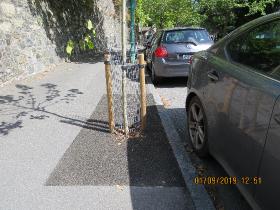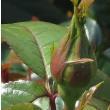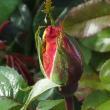Ivydene Gardens Home: |
READING THE TEXT IN RED ON THIS PAGE WILL MAKE IT EASIER FOR YOU TO USE EACH PAGE in my educational website.
THE 2 EUREKA EFFECT PAGES FOR UNDERSTANDING SOIL AND HOW PLANTS INTERACT WITH IT OUT OF 17,000:-
Explanation of Structure of this Website with User Guidelines Page for those photo galleries with Photos (of either ones I have taken myself or others which have been loaned only for use on this website from external sources) |
HOME PAGES Welcome - Ivydene Gardens informs you how to design, construct and maintain your private garden using organic methods and companion planting. Sub Menu to each Page of this Topic of the HOME PAGES, with normally a * after Page you are viewing.
Damage to Tree Trunks 1, 2, 3, 4 caused by people, Camera Photo Galleries:- Will visitors to Madeira worry about having branches or trees in public places fall on them? No; according to Engineer Francisco Pedro Freitas Andrade of Est. Marmeleiros, No 1, Jardins & Espaces Verdes who is Chef de Diviso Câmara Municipal do Funchal; Departamento de Ciência e de Recursos Naturais; Divisão de Jardins e Espaços Verdes Urbanos in charge of the trees within the pavements within the area controlled by Funchal Municipality - See Monitoring of Trees in pavements in Funchal, Madeira from September 2019 to February 2010 1, 2 pages by his department. PROBLEMS WITH TREES IN PAVEMENTS IN ST. PETER PORT, GUERNSEY IN SEPTEMBER 2019 |
Guernsey has decided to replace the ground exposed within a small distance from the trunk of trees within pavements in St Julian's Avenue in St.Peter Port with tarmac. This has also been done in tarmaced paths in Candie Gardens. I noticed that the garden beds in Candie Garden were well weeded with bare soil between the plants. This seems to be the accepted practice in Guernsey. Shame that the trees/shrubs in that garden are not mulched in order to provide humus to feed them and keep the soil as soil instead of it returning to being sand, silt or clay - see soil structure diagram in Tree Problems in pavements in Funchal, Madeira in February 2018 page for the linkage between sand, clay domains, bacterium and organic polymers. The Death of Tree Roots in Madeira caused by people page details why this is detrimental to the trees. On the right hand side of that page is a practical solution to keeping your trees. Currently you will lose both the mature trees and the juvenile trees due to lack of oxygen, water, nutrients and soil that can be penetrated by the tree roots. |
||
|
|
|
Page 3 of Perry's Professional Map of Guernsey showing |
|
|
One of the trees still with its small exposed area of ground for it to receive water, etc in If this tree is 5 metres high, then it's roots spread at least 5 metres in radius from the trunk. In geometry, the area enclosed by a circle of radius r is π r2. Here the Greek letter π represents a constant, approximately equal to 3.14159, which is equal to the ratio of the circumference of any circle to its diameter. Area = 3.14 x 5 x 5 = 78.5 It is likely that the exposed ground does not exceed much more than 1 square metre, so we have been generous in providing access to rain, nutrients, oxygen etc for only 1.27% of the roots of this tree. The others which this space has been covered with tarmac, or in the case of juvenile trees with a 10cm square hole, then 0% of the roots have any access. This is of course the recommended treatment for babies - provide mother with milk but no way for the baby to receive it. IMG 0021 is 4000 x 3000 pixels. |
|
|
Newly planted juvenile tree surrounded by tarmac in IMG 0006 is 4000 x 3000 pixels |
|
|
Same newly planted juvenile tree surrounded by tarmac in IMG 0007 is 4000 x 3000 pixels I would advise that the rubber ties should be about 50 cms (20 inches) above ground, so that the tree trunk will flex in the wind and thus decide to strengthen itself as the tree grows to be able to support the upper foliage and branches. If the tree ties are too high, then when they are removed, the trunk may not be sufficiently strong in high winds to prevent itself from being snapped. This 2 post system is correct, since this kind of support is only required during the first 2 or 3 years in this position. Then when the ties are removed, the posts can be also without damaging the tree roots. |
|
|
Mature tree surrounded by tarmac in IMG 00016 is 4000 x 3000 pixels |
|
|
Redcurrant growing in Victorian Walled Kitchen Garden in Guernsey. IMG 0055 is 4000 x 3000 pixels As in many gardens that I saw in Guernsey, there is no mulch or green manure, which feeds, shades the ground, prevents wind and sun drying out the ground as well as reducing weeding. |
|
|
I have copied this Plant Care section from the Introduction Page of the It is a pity that the people in Madeira and Guernsey seem to have lost the
|
||
Plant Care This is a photo of a Ryegrass plant, that was growing in Type I MOT Roadstone on
|
||
. That root in cooperation with worms, bacteria etc takes in food, which is brought If you buy Sharp-Washed-Sand from a Builder's Merchant and put that into a clean To make that Sharp-Washed-Sand into soil, you need dead plant material, shit from You can then see that a Sandy Soil is much easier for the roots of a plant to get into, A clay soil is more difficult for plants, since when it rains the tunnels fill up with water and A mixture of Clay and Soil is best (Click on Soil Formation - What is Soil Texture?).
I saw a yew tree that had been planted in a churchyard in 2000 as a 2 foot high tree. In 2009 It was planted on a 30 degree slope in clay/sand soil with grass growing round its base. It had
So, I carefully removed the grass and its roots from around its base out to the tips of the tree In Maderia I saw a mature olive tree - which had been transplanted from the nursery to a roof An organic mulch about 4 inches deep on weeded soil makes garden maintenance very easy. If your garden is on a steep slope - I maintained one that had half-circle beds with lawn paths Roots of plants that you put into your garden do extend and grow, but the existing roots do not A minor point that people forget is that you only live because you can breath oxygen, and plants . |
||
This website is being created by Chris Garnons-Williams of Ivydene Horticultural Services from it's start in 2005. It should be remembered that nothing is sold from this educational site, it simply tries to give you the best advice on what to use and where to get it (About Chris Garnons-Williams page details that no payment or commision to or from any donor of photos or adverts I place on the site in the Useful Data or other sections is made to Chris Garnons-Williams or Ivydene Horticultural Services). This website is a hobby and not for direct commercial gain for Ivydene Horticultural Services. There is no Google Adscenes or Search Facility in this website. The information on this site is usually Verdana 14pt text (from December 2023, this is being changed from 14pt to 10pt) and all is in tabular form. This can be downloaded and sorted using WORD or other word-processing software into the order that you personally require, especially for soil subsidence, the Companion Planting Tables and the pages in the Plants section. This would be suitable for use in education as well. I put jokes in at various places to give you a smile. |
Site design and content copyright ©April 2007. Page structure amended October 2012. Page structure changed February 2019 for pages concerning Trees in pavements alongside roads in Madeira. Chris Garnons-Williams. DISCLAIMER: Links to external sites are provided as a courtesy to visitors. Ivydene Horticultural Services are not responsible for the content and/or quality of external web sites linked from this site. |
|
|
||
The following is from "Some time around 600 million years ago, green algae began to move out of shallow fresh waters and onto the land. They were the ancestors of all land plants... Today, plants make up to 80% of the mass of all life on Earth and are the base of the food chains that support nearly all terrestrial organisms.... But the algal ancestors of land plants had no roots, no way to store or transport water, and no experience in extracting nutrients from solid ground. How did they manage the fraught passage onto dry land? ... It was only by striking up new relationships with fungi that algae were able to make it onto land. These early alliances evolved into what we now call mycorrhizal relationships. Today, more than 90% of all plant species depend on mycorrhizal fungi. Mycorrhizal associations are the rule not the exception: a more fundamental part of planthood than fruit, flowers, leaves, wood or even roots.... For the relationship to thrive, both plant and fungus must make a good metabolic match. In photosynthesis, plants harvest carbon from the atmosphere and forge the energy-rich carbon compounds - sugars and lipids - on which much of the rest of life depends. By growing within plant roots, mycorrhizal fungi acquire privileged access to these sources of energy: they get fed. However, photosynthesis is not enough to support life. Plants and fungi need more than a source of energy. Water and minerals must be scavenged from the ground - full of textures and micropores, electrically charged cavities and labyrinthine rot-scapes. Fungi are deft rangers in this wilderness and can forage in a way that plants can not. By hosting fungi within their roots, plants gain hugely improved access to these sources of nutrients. They, too, get fed. By partnering, plants gain a prosthetic fungus, and fungi gain a prosthetic plant. Both use the other to extend their reach.... By the time the first roots evolved, the mycorrhizal association was already some 50 million years old. Mycorrhizal fungi are the roots of all subsequent life on land. Today, hundreds of millions of years later, plants have evolved, faster-growing, opportunistic roots that behave more like fungi. But even these roots cannot out-manoeuvre fungi when it comes to exploring the soil. Mycorrhizal hyphae are 50 times finer than the finest roots and can exceeed the length of a plant's roots by as much as a 100 times. Their mycelium makes up between a third and a half of the living mass of soils. The numbers are astronomical. Globally, the total length of mycorrhizal hyphae in the top 10 centimetres (4 inches) of soil is around half the width of our galaxy (4.5 x 10 to the power 17 kilometres versus 9.5 x 10 to the power 17 kilometres). If these hyphae were ironed into a flat sheet, their combined surface area would cover every inch of dry land on Earth 2.5 times over.... In their relationship, plants and mycorrhizal fungi enact a polarity: plant shoots engage with the light and air, while the fungi and plant roots engage with the solid ground. Plants pack up light and carbon dioxide into sugars and lipids. Mycorrhizal fungi unpack nutrients bound up in rock and decomposing material. These are fungi with a dual niche: part of their life happens within the plant, part in the soil. They are stationed at the entry point of carbon into terrestrial life cycles and stitch the atmosphere into relation with the ground. To this day, mycorrhizal fungi help plants cope with drought, heat and many other stresses life on land has presented from the very beginning, as do the symbiotic fungi that crowd into plant leaves and stems. What we call 'plants' are in fact fungi that have evolved to farm algae, and algae that have evolved to farm fungi.... Mycorrhizal fungi can provide up to 80% of a plant's nitrogen, and as much as 100% of its phosphorus. Fungi supply other crucial nutrients to plants, such as zinc and copper. They also supply plants with water, and help them to survive drought as they have done since the earliest days of life on land. In return, plants allocate up to 30% of the carbon they harvest to their mycorrhizal partners.... And yet mycorrhizal fungi do more than feed plants. Some describe them as keystone organisms; others prefer the term 'ecosystem engineers'. Mycorrhizal mycelium is a sticky living seam that holds soil together; remove the fungi, and the ground washes away. Mycorrhizal fungi increase the volume of water that the soil can absorb, reducing the quantity of nutrients leached out of the soil by rainfall by as much as 50%. Of the carbon that is found in soils - which, remarkably, amounts to twice the amount of carbon found in plants and the atmosphere combined - a substantial proportion is bound up in tough organic compounds produced by mycorrhizal fungi. The carbon that floods into the soil through mycorrhizal channels supports intricate food webs. Besides the hundreds or thousands of metres of fungal mycelium in a teaspoon of healthy soil, there are more bacteria, protists, insects and arthropods than the number of humans who have ever lived on Earth. Mycorrhizal fungi can increase the quality of a harvest. They can also increase the ability of crops to compete with weeds and enhance their resistance to diseases by priming plant's immune systems. They can make crops less susceptible to drought and heat, and more resistant to salinity and heavy metals. They even boost the ability of plants to fight off attacks from insect pests by stimulating the production of defensive chemicals... But over the course of the twentieth century, our neglect has led us into trouble. In viewing soils as more or less lifeless places, industrial agricultural practices have ravaged the undergound communities that sustain the life we eat.... A large study published in 2018 suggested that the 'alarming deterioration' of the health of trees across Europe was caused by a disruption of their mycorrhizal relationships, brought about by nitrogen pollution." from Before Roots chapter by Merlin Sheldrake.
"We do know, that this fragile, generative world has been damaged by intensive farming, pollution, deforestation and global heating. A third of the planet's land has been severely degraded and 24 billion tons of fertile soil are destroyed every year through intensive farming, according to the Global Land Outlook. Topsoil is where 95% of the planet's food is grown and is very delicate. It takes more than 100 years to build 5mm of soil, and it can be destroyed shockingly easily. This destruction and degradation of the soil is created by intensive farming practices such as heavy mechanised soil tilling, which loosens and rips away any plant cover, leaving the soil bare. It is also caused by the overgrazing of animals, as well as forest fires and heavy construction work. These factors disturb the soil and leave it exposed to erosion from wind and water, damaging the complicated systems underneath its top layer... We are losing good soil at an estimated 100 times faster rate than we can remake and heal it. The world's soils are thought to store approximately 15 thousand million tonnes of carbon - 3 times as much as all of our planet's terrestrial vegetation combined. Soils hold twice as much carbon as the atmosphere, and when soil disintegrates, the carbon is released. In the last 40 years the soil in the UK's croplands lost 10% of the carbon it could store. In a time of climate crisis, soil's quiet potency, its ability to store carbon safely, is utterly essential to our future survival.... We know that soils are being destroyed, and that with that comes a higher risk of floods, and a more unpredictable and unreliable food and water system. An Intergovernmental Science-Policy Platform on Biodiversity and Ecostem Services report in 2018 told us clearly that land degradationis already putting the welfare of two-fifths of humanity at risk, and that urgent action is needed to avoid further danger. There are many things we can do to protect soils, and the organisms, plants and connections that thrive within them. Actions that can support and heal soil structure include
Such regimes allow soil structure to remain intact, and protect the soil by allowing crop residues to stay on the surface. " from Strange Soil chapter by Rebecca Tamas. |
Due to intensive farming techniques and chemical fertilisers this has occurred:- The BBC has produced an article as to why modern food as lost its nutrients. |
The following about trees in pavements show why when the roots are denied access to air, water and nutrients even the fungi cannot work to support the trees. Pavements of Funchal, Madeira |
The following addition of this mulch improved the clay soil, so that A 150mm deep mulch of mixed peat, sharp washed sand and horticultural grit was applied on top of a heavy clay soil to improve its structure, and stop the plants therein from drowning, at £10 a square metre. The mix was:
The following was then sent to me:-
and the following was sent to me in October 2004:- An unsuccessful planting scheme had left bare areas of garden as plants failed to survive winter in the waterlogged clay soil. The loss of numerous plants and the cost of replacing them had left us disheartened. It was evident that remedial action was need in the form of a mixture of gravel, sand and peat to create an organic loam. Approximately six inches was added in April and left to settle and do its job. By July there was a noticeable difference in the quality of the soil and the plants. Shrubs with sparse, mottled leaves were looking glossy and robust, overall growth had increased (including the weeds!) and the soil was holding its moisture well. But the biggest difference came in the confidence it gave us to transform the garden. The borders used to be a no-go area between May and September as the clay baked and cracked, but the new soil was easy to handle and weeds could be successfully removed. We realised that there are no quick fixes - the key to a healthy garden is rich, nutritous soil. Once our plants began to thrive we were optimistic that, with good advice, we could create a garden to be proud of. |
More Details |
Cultural Needs of Plants "Understanding Fern Needs |
|
It is worth remembering that especially with roses that the colour of the petals of the flower may change - The following photos are of Rosa 'Lincolnshire Poacher' which I took on the same day in R.V. Roger's Nursery Field:- |
|
Closed Bud |
|
Opening Bud |
|
Juvenile Flower |
|
Older Juvenile Flower |
|
Middle-aged Flower - Flower Colour in Season in its |
|
Mature Flower |
|
Juvenile Flower and Dying Flower |
|
Form of Rose Bush |
There are 720 roses in the Rose Galleries; many of which have the above series of pictures in their respective Rose Description Page. So one might avoid the disappointment that the 2 elephants had when their trunks were entwined instead of them each carrying their trunk using their own trunk, and your disappointment of buying a rose to discover that the colour you bought it for is only the case when it has its juvenile flowers; if you look at all the photos of the roses in the respective Rose Description Page!!!! |
|
There are 180 families in the Wildflowers of the UK and they have been split up into 22 Galleries to allow space for up to 100 plants per gallery. Each plant named in each of the Wildflower Family Pages may have a link to:- its Plant Description Page in its Common Name in one of those Wildflower Plant Galleries and it does have links:- to external sites to purchase the plant or seed in its Botanical Name, to see photos in its Flowering Months and to read habitat details in its Habitat Column. |
|
Links to external websites like the link to "the Man walking in front of car to warn pedestrians of a horseless vehicle approaching" would be correct when I inserted it after March 2007, but it is possible that those horseless vehicles may now exceed the walking pace of that man and thus that link will currently be br My advice is Google the name on the link and see if you can find the new link. If you sent me an email after clicking Ivydene Horticultural Services text under the Worm Logo on any page, then; as the first after March 2010 you would be the third emailer since 2007, I could then change that link in that 1 of the 15,743 pages. Currently (August 2016). Other websites provide you with cookies - I am sorry but I am too poor to afford them. If I save the pennies from my pension for the next visitor, I am almost certain in March 2023, that I could afford to make that 4th visitor to this website a Never Fail Cake. I would then be able to save for more years for the postage. |






















